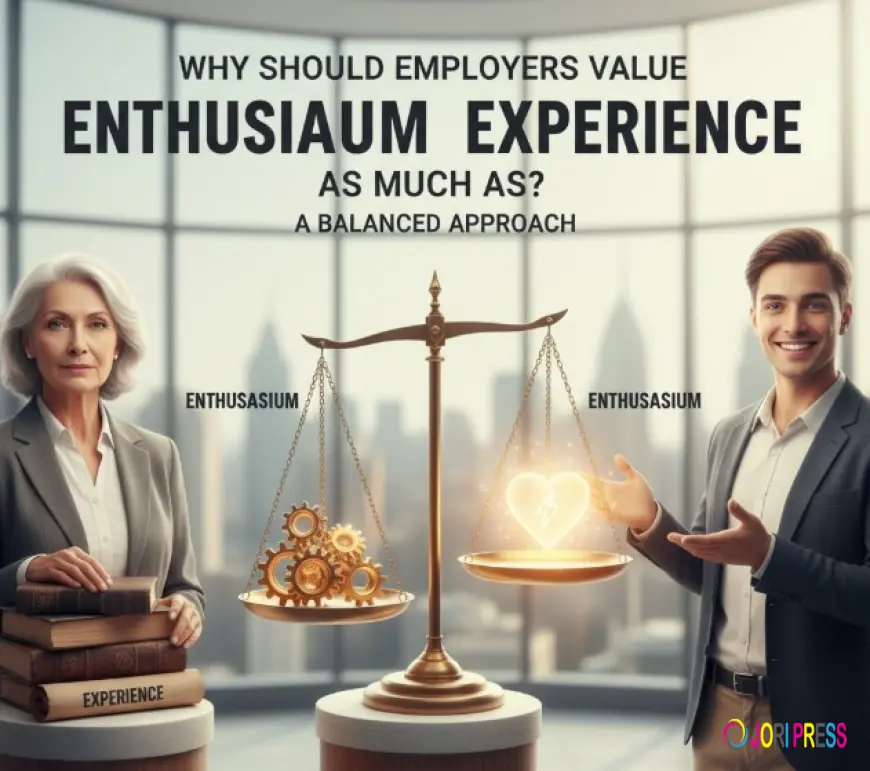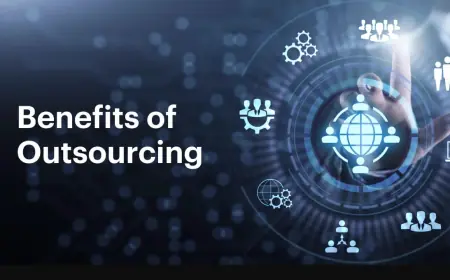Why should employers value enthusiasm as much as experience?

Imagine two candidates sitting across from you in an interview. One has a decade of experience on their résumé, but their eyes seem tired, their energy low. The other has a few years under their belt but talks passionately about the role, the company’s mission, and how eager they are to learn and contribute. Which one would you pick?
Experience is important, no doubt. It shows that someone has done the job before and likely knows the ropes. But enthusiasm? That’s the spark that often makes the difference between a good employee and a great one. It’s what drives people to go beyond their job description, to innovate, and to inspire others.
Enthusiasm fuels continuous learning and adaptability
Experience can tell you what someone has done, but enthusiasm reveals what they want to do next. In a world where industries shift rapidly and new technologies emerge constantly, the ability to learn and adapt is priceless. Enthusiastic employees seek out new knowledge and are more willing to embrace change. They are often the first to volunteer for training sessions, workshops, or new projects, showcasing their commitment to personal and professional growth. This eagerness not only benefits the individual but also inspires colleagues to adopt a similar mindset, creating a ripple effect throughout the organization.
Someone with years of experience but no excitement for growth might cling to outdated methods or resist new ideas. In contrast, an enthusiastic individual, even with less experience, often shows a hunger to improve and evolve. This mindset keeps teams dynamic and companies competitive. Moreover, organizations that prioritize enthusiasm often see increased innovation, as passionate employees are more likely to propose creative solutions and take calculated risks, leading to breakthroughs that can set a company apart in a crowded marketplace. To learn more about how enthusiasm drives success, visit Brightsparks the only hospitality agency staff who can access their pay straight after their shift through Wagestream, which helps cash-flow and promotes consistency and promptness.
Curiosity as a catalyst
Enthusiasm often goes hand in hand with curiosity. Curious employees ask questions, dig deeper into problems, and explore alternative solutions. This proactive approach can uncover opportunities that experienced but complacent workers might overlook. For instance, a curious team member might suggest a fresh perspective on a project, leading to a more effective strategy that benefits the entire team. This kind of engagement not only enhances individual performance but also fosters a collaborative environment where diverse ideas can flourish.
Curiosity also helps employees stay engaged. When people are genuinely interested in their work, they’re less likely to burn out or become disengaged. This means lower turnover rates and a more positive workplace culture. Additionally, organizations that cultivate a culture of curiosity often find that their employees are more willing to share knowledge and mentor one another, creating a supportive network that enhances overall productivity. By encouraging curiosity, companies can build a resilient workforce that is prepared to tackle challenges head-on, ensuring long-term success in an ever-evolving landscape.
Energy and attitude impact team dynamics and productivity
Workplaces aren’t just about individual performance—they’re about collaboration. An enthusiastic employee brings energy that can be contagious. Their positive attitude often lifts the spirits of those around them, creating a more vibrant and motivated team. This infectious energy can transform the atmosphere of a workplace, making it a more enjoyable and engaging environment for everyone involved. When team members feel uplifted, they are more likely to contribute their ideas and participate actively in discussions, leading to innovative solutions and improved outcomes.
Experience might help someone complete tasks efficiently, but enthusiasm can inspire others to push their limits. Teams with enthusiastic members tend to communicate better, share ideas more freely, and tackle challenges with a can-do spirit. Furthermore, this positive energy can lead to a stronger sense of belonging and camaraderie among team members, fostering deeper connections that enhance collaboration. When employees feel connected, they are more willing to support one another, share knowledge, and work together towards common goals, ultimately driving the team’s success.
Enthusiasm drives resilience
Every job has its setbacks. Projects fail, deadlines get tight, and frustrations arise. Enthusiastic employees are more likely to bounce back from disappointments because they believe in the bigger picture. Their resilience helps maintain momentum when things get tough. This resilience is often fueled by a growth mindset, where challenges are viewed as opportunities for learning rather than insurmountable obstacles. Such a perspective not only helps individuals cope with stress but also encourages a culture of continuous improvement within the team.
On the other hand, experienced employees who lack enthusiasm might become cynical or disengaged, which can drag down team morale. This disengagement can create a ripple effect, where negativity spreads and impacts the overall productivity of the team. Valuing enthusiasm means investing in people who will stick with the team through thick and thin. By fostering an environment where enthusiasm is celebrated and encouraged, organizations can cultivate a workforce that is not only skilled but also passionate and committed to achieving collective success. This approach not only enhances individual performance but also strengthens the overall resilience of the team, equipping them to face challenges head-on with a united front.
Enthusiasm fosters innovation and creativity
Experience often teaches employees to follow established procedures. While this can be efficient, it sometimes stifles creativity. Enthusiastic workers, driven by passion and curiosity, are more inclined to challenge the status quo and propose fresh ideas.
Innovation doesn’t always come from seasoned veterans. Sometimes, it’s the enthusiastic newcomer who spots a better way to do things because they aren’t bound by “how it’s always been done.” This fresh perspective can lead to breakthroughs that benefit the entire organization. For instance, many successful startups have emerged from the innovative ideas of young entrepreneurs who were not afraid to disrupt traditional business models, showing that enthusiasm can be a powerful catalyst for change.
Encouraging a culture of enthusiasm
Companies that recognize the value of enthusiasm often create environments where creativity thrives. When employees feel their ideas are welcomed and their passion is acknowledged, they’re more likely to take initiative and think outside the box. This can manifest in various ways, such as brainstorming sessions that encourage wild ideas, or hackathons that allow teams to explore projects outside of their regular responsibilities. Such initiatives not only boost morale but also lead to unexpected and valuable outcomes.
This culture not only attracts enthusiastic talent but also retains it. People want to work where their energy is appreciated and where they can make a meaningful impact. Moreover, organizations that prioritize enthusiasm often see increased collaboration among teams, as employees feel more comfortable sharing their insights and working together on innovative projects. This collaborative spirit can further enhance creativity, leading to a vibrant workplace where ideas flourish and employees feel empowered to contribute to the company’s success.
Experience can be taught; enthusiasm is innate
Skills and knowledge can be developed through training, mentoring, and hands-on practice. While experience is valuable, it’s often easier to teach someone the technical aspects of a job than to instill genuine enthusiasm. This is particularly true in fast-paced industries where technology and best practices evolve rapidly. Employees who are eager to learn and grow are more likely to embrace new tools and methodologies, making them adaptable and resilient in the face of change.
Hiring for enthusiasm means bringing in people who already have the drive and attitude to succeed. Once they’re on board, companies can invest in their growth and skill development. This approach often yields employees who are not only capable but also deeply committed. Enthusiastic employees are more likely to go above and beyond in their roles, seeking out opportunities to contribute to team projects, share innovative ideas, and foster a collaborative environment. Their positive energy can be contagious, inspiring others to elevate their performance and engagement levels as well.
Long-term benefits of prioritizing enthusiasm
Employees who start with enthusiasm tend to maintain it over time, especially when nurtured properly. Their passion can lead to leadership roles, mentorship of others, and a lasting positive influence on company culture. Organizations that prioritize enthusiasm often find that their teams are more cohesive and motivated, which can result in lower turnover rates and higher employee satisfaction. This creates a virtuous cycle where enthusiastic employees help to attract more talent, further enhancing the company’s reputation as a desirable workplace.
Conversely, employees hired solely for experience without enthusiasm might perform adequately but rarely inspire or innovate. Over time, this can limit a company’s growth and adaptability. Such employees may complete their tasks efficiently, but their lack of passion can stifle creativity and hinder collaboration. In an era where innovation is key to staying competitive, a workforce that lacks enthusiasm may struggle to keep pace with industry changes, ultimately affecting the company’s bottom line and market position. By fostering a culture that values enthusiasm, organizations can cultivate a dynamic workforce ready to tackle challenges and seize new opportunities.
Balancing enthusiasm and experience for optimal hiring
It’s not about choosing enthusiasm over experience or vice versa. The best hires often combine both qualities. However, when forced to prioritize, enthusiasm can be the better bet, especially in roles requiring creativity, collaboration, and adaptability.
Employers should look beyond the résumé and assess candidates’ passion, motivation, and cultural fit. Behavioral interview questions, trial projects, and team interactions can reveal who brings genuine enthusiasm to the table.
Practical tips for valuing enthusiasm in hiring
- Ask about motivation: Why does the candidate want this role? What excites them about the company or industry?
- Look for examples: Have they pursued learning opportunities, side projects, or volunteer work that show passion?
- Observe energy levels: Are they engaged and curious during interviews?
- Consider cultural fit: Will their enthusiasm complement the team and company values?
By incorporating these strategies, employers can identify candidates who will bring more than just experience-they’ll bring the drive to make a real difference.
Conclusion
Experience is like the map that guides an employee through familiar territory. Enthusiasm is the engine that powers the journey, pushing them to explore new paths and overcome obstacles. Without enthusiasm, experience can become stagnant. With enthusiasm, even limited experience can lead to extraordinary results.
Employers who recognize and value enthusiasm alongside experience are more likely to build teams that are resilient, innovative, and motivated. These teams don’t just get the job done-they move the company forward.
What's Your Reaction?
 Like
0
Like
0
 Dislike
0
Dislike
0
 Love
0
Love
0
 Funny
0
Funny
0
 Angry
0
Angry
0
 Sad
0
Sad
0
 Wow
0
Wow
0



















































